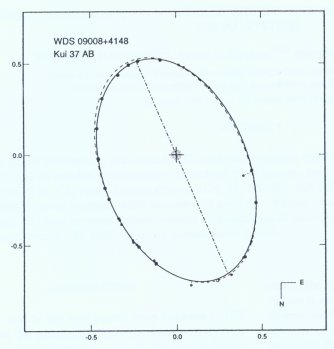
 |
The G5 dwarf component of 10 UMa orbits the more massive F5 dwarf with a period of 21.8 years at an average distance of 10.6 Astronomical Units. The orbit seen here is tilted by 55 degrees to the line of sight. The dashed line is the original orbit, the solid a new one, showing that the data are all remarkably accurate. In reality the two stars orbit a common center of mass, whereas here, we place the coordinates such that the lesser seems to orbit the more massive of the two. The dot-dash line shows the "line of nodes," where the apparent orbit seems to slice across the "plane of the sky." The scale is in seconds of arc. Names from double- star catalogues are in the upper left hand corner. From a paper by W. I. Hartkopf, B. D. Mason, and H. A. McAlister in the Astronomical Journal, vol. 111, p. 370, 1996. |